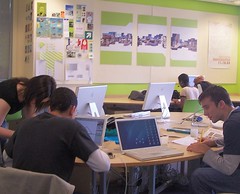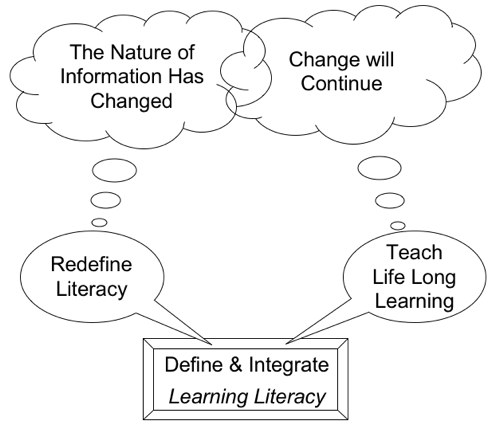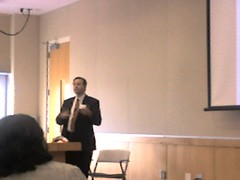 So, let’s get to it. What’s good about the “Seeing No Progress, Some Schools Drop Laptops” article, written for The New York Times by Winnie Hu, is that this story was not limited only to people who live within the NYTimes paper delivery area. It was immediately available to readers around the world — including youngsters, sitting at their desks, their laptops open, browsers engaged, accessing and interacting with a global library of content.
So, let’s get to it. What’s good about the “Seeing No Progress, Some Schools Drop Laptops” article, written for The New York Times by Winnie Hu, is that this story was not limited only to people who live within the NYTimes paper delivery area. It was immediately available to readers around the world — including youngsters, sitting at their desks, their laptops open, browsers engaged, accessing and interacting with a global library of content.
While the article’s URL was hopscotching the continents from one ed tech advocate to another, students could, regardless of their geographic location, also read and consider the story — and the rather dramatic conclusions that it implied based on such absurdly little evidence.
No doubt, some students concur. Their teachers don’t know what to do with these state-of-the-art computers, sitting between them and their darlings. They’ve been taught how to operate the machines, but little more, and they don’t bother to hide their frustrations and resentment at being pushed into futuristic classrooms that they are neither prepared for nor believe in.
“I’ve covered this material perfectly well for twenty years.” They’d say, “Why change now!”
And computers do go un-repaired for days and even weeks for these students, because the district has not hired additional technical staff for the hundreds of new computers. And available power and bandwidth have, evidently, not been considered by the school and central office administration as they scurried to jump on to yet another bandwagon, without the appropriate planning.
Just as certainly, there were many youngsters, laptops on desk, scanning the story in astonishment, and seeking to reconcile these claims with their own experience in laptop classrooms. These students Googled laptop schools, and although there were some articles about the successes of technology infused schools, they were not so plentiful — because sadly, that is not considered the news story that presumed mistakes at high levels is.
But they find statistics, and they find pictures, and they record the sounds of their clickety-clicking at their keyboards, and the conversations in their classes, and they mix and remix the information to tell their story with multimedia, and podcast it to the world. Alas, their parents see them, and rejoice in how tech-savvy their children are. But The New York Times pays no attention — that’s not news.
Their scores on their government tests do not increase dramatically, but the skills they are developing: to ask essential questions, research, evaluate, collaborate, process, mix and remix, and publish their findings — learning to be active learners in a rapidly changing world — these skills are not tested.
In a world, where local news is global, and global news is local, where a reporters value is measured in how much angst can be generated by their writing, the 3Rs are no longer enough. They are merely elemental — compared to the rich and exciting information skills that are absolutely critical to not only our children’s future, but ours as well. ..and gaining this new information skills can only happen from within this new information landscape. It’s why every child should be walking into their classroom with a computer under their arm, every classroom should breath with the global information landscape, and every teacher should trained and practiced in the life-long-learning literacies of the emerging future.
Hu, Winnie. “Seeing No Progress, Some Schools Drop Laptops.” The New York Times 4 May 2007 4 May 2007 <http://tinyurl.com/27g53r>.
 One of the world altering aspects of the Internet is that it brings us closer together. This is not always a good thing, and regardless of my published objections to the attention grabing fear tactics used by some, it is essential to acknowledge that inappropriate uses and even dangerous opportunities exist there. There are people out there whom we do not want our children to come in contact with. There are also retired grandmothers, such as Mary Conyers, who bless us with their drive and dedication.
One of the world altering aspects of the Internet is that it brings us closer together. This is not always a good thing, and regardless of my published objections to the attention grabing fear tactics used by some, it is essential to acknowledge that inappropriate uses and even dangerous opportunities exist there. There are people out there whom we do not want our children to come in contact with. There are also retired grandmothers, such as Mary Conyers, who bless us with their drive and dedication.
 I just met a fellow in Second Life from Rotterdam, and he pointed me to his blog,
I just met a fellow in Second Life from Rotterdam, and he pointed me to his blog,  That Four Eyed technologist, the Existential Paine, blogged yesterday about an upcoming conference to be held on Second Life — about Second Life best practices.
That Four Eyed technologist, the Existential Paine, blogged yesterday about an upcoming conference to be held on Second Life — about Second Life best practices. So, let’s get to it. What’s good about the “
So, let’s get to it. What’s good about the “ As you, no doubt, already know, I saw a presentation on Wednesday from Tim Magner, ed tech guy from the U.S. Department of Education. I’ve already written a good bit about that presentation and the even better showcase from classrooms across North Carolina. I’ve even commented on some comments that I received, including one expressing disappointment that Tim was not offering some “grand idea” for bringing classrooms and school into the current century.
As you, no doubt, already know, I saw a presentation on Wednesday from Tim Magner, ed tech guy from the U.S. Department of Education. I’ve already written a good bit about that presentation and the even better showcase from classrooms across North Carolina. I’ve even commented on some comments that I received, including one expressing disappointment that Tim was not offering some “grand idea” for bringing classrooms and school into the current century.
 Magner is telling a compelling story about a need for new teaching and learning, for new classrooms, for a rethinking of the entire system. I do have to admit, however, that I am no more optimistic that we’re going to be able to pull it off. He said that we have no common language for reshaping a vision for 21st century education, and he is correct. It’s why the new story has to be plain, simple, and energizing.
Magner is telling a compelling story about a need for new teaching and learning, for new classrooms, for a rethinking of the entire system. I do have to admit, however, that I am no more optimistic that we’re going to be able to pull it off. He said that we have no common language for reshaping a vision for 21st century education, and he is correct. It’s why the new story has to be plain, simple, and energizing.

 This in from ETAN (EdTechActionNetwork).
This in from ETAN (EdTechActionNetwork).